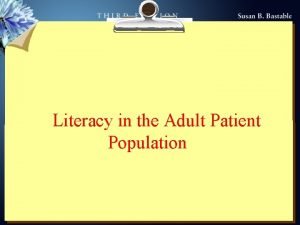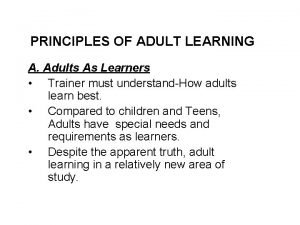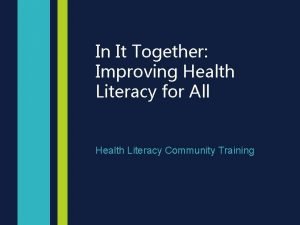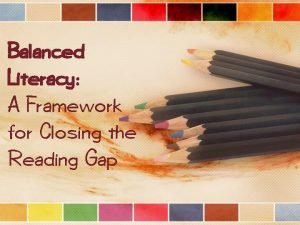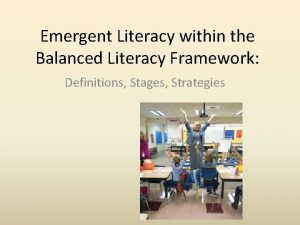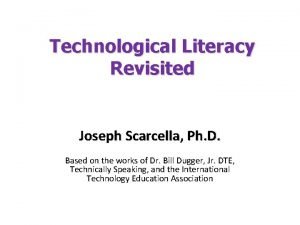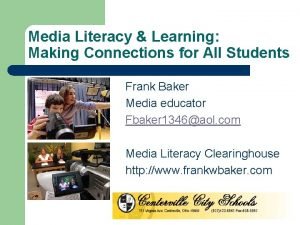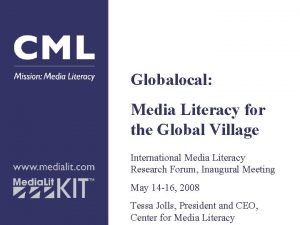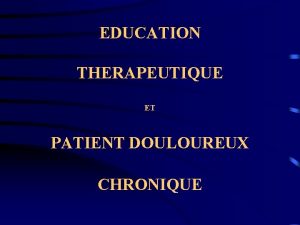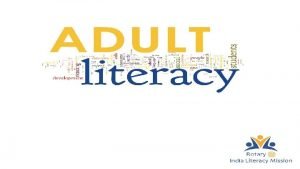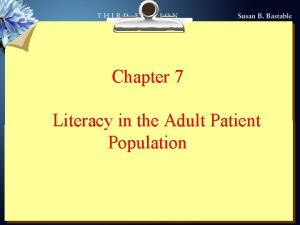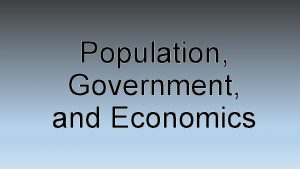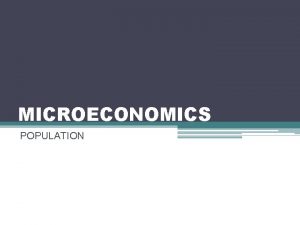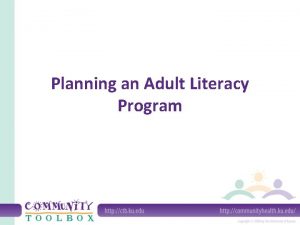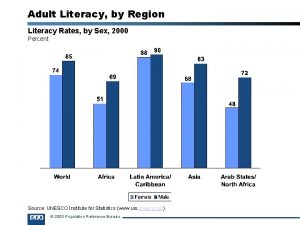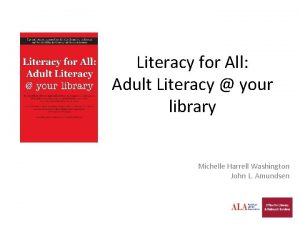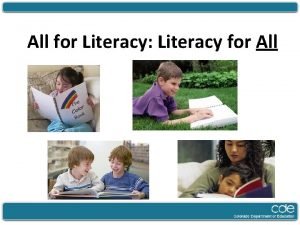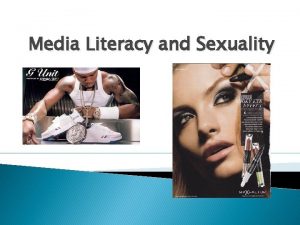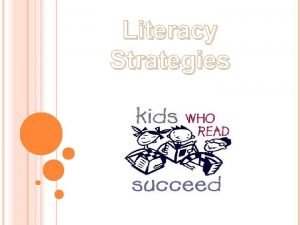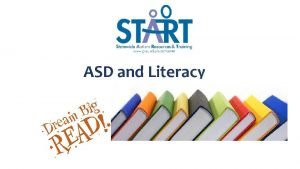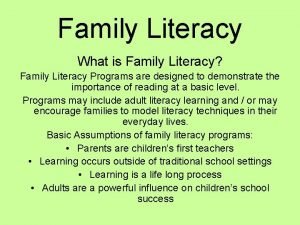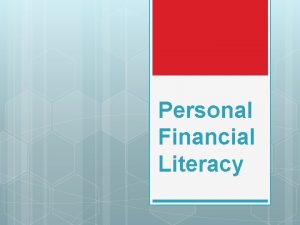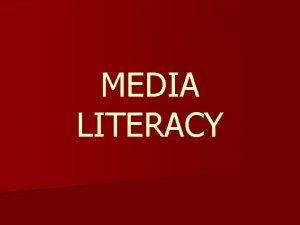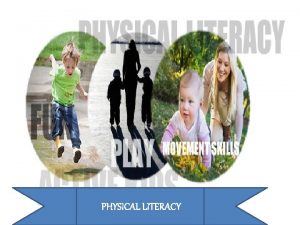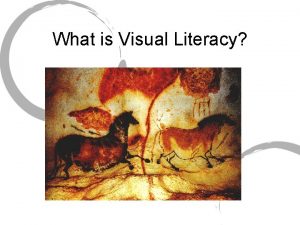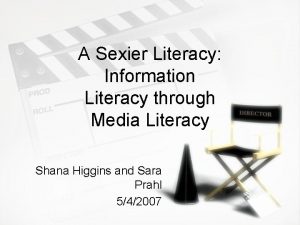Literacy in the Adult Patient Population Definition of






























































- Slides: 62

Literacy in the Adult Patient Population

Definition of Terms Literacy: the ability of adults to read, write, and comprehend information at the 8 th-grade level or above. Illiteracy: the total inability of adults to read, write, and comprehend information. Low Literacy: the ability of adults to read, write, and comprehend information between the 5 th- to 8 th-grade level of difficulty. Also synonymous with the terms marginally literate or marginally illiterate.

Definition of Terms (cont’d) Health Literacy: the ability to read, interpret, and comprehend health information to maintain optimal wellness. Functional Illiteracy: the inability of adults to read, write, and comprehend information below the 5 th-grade level of difficulty in order to use information as it is intended for effective functioning in today’s society. Readability: the ease with which written or printed information can be read.

Definition of Terms (cont’d) Comprehension: the degree to which individuals understand accurately interpret what they have read. Numeracy: the ability to read and interpret numbers. Reading: the ability to transform letters into words and pronounce them correctly (word recognition).

Literacy Relative to Oral Instruction Little attention has been paid to the role of oral communication in the assessment of illiteracy. Iloralacy: the inability to comprehend simple oral language communicated through speaking of common vocabulary, phrases, or slang words.

Literacy Relative to Computer Instruction • The ability to use computers for communication is an increasingly popular issue with respect to literacy of learner. • As an educational tool, the potential for computers is increasingly being realized and appreciated by healthcare providers. • Computers are used to convey as well as to access information.

• Scope and Incidence of Literacy Problem The U. S. ranks only 49 th from the top among 159 members in the United Nations in average national literacy level. • Approximately 40 to 45 million Americans are considered illiterate and an additional 50 million Americans are low literate. • That is, about one fifth, or 21– 23% of the adult U. S. population lacks literacy skills needed to acquire knowledge to cope with the requirements of day-today living.

Scope and Incidence of Literacy Problem (cont’d) • Estimates of the problem are conservative due to the difficulty in defining and testing literacy levels and because few people admit to being illiterate or low literate. • The mean literacy level of Americans is at or below the 8 th grade. • The rates of illiteracy and low literacy are expected to continue to rise due to the increasing complexity of technological and informational demands.

Trends associated with literacy problems • • • A rise in the number of immigrants The aging of our population The increasing complexity of information The added number of people living in poverty Changes in policies and funding for public education • Disparity of opportunity between minority versus non-minority populations

Those at Risk • • • The economically disadvantaged The elderly Immigrants (particularly illegal ones) High-school dropouts Racial minorities The unemployed Prisoners Inner city and rural residents Those with poor health status

Myths, Stereotypes and Assumptions Myth #1: People who are illiterate have below normal IQ’s. Myth #2: People who are illiterate can be recognized by their appearance & backgrounds Myth #3: The number of years of schooling completed correlates with literacy skills. Myth #4: People who are illiterate freely admit to having problems with reading, writing and comprehension.

Assessment: Clues to look for Most people with limited literacy abilities are masters of concealment. Possible signs of poor or nonexistent reading ability include: • reacting to complex learning situations by withdrawal or avoidance • using the excuse of being too busy, not interested, too tired, or not feeling well enough to read instructional materials

Assessment: Clues to look for (cont’d) • claiming they lost, forgot, or broke their glasses • insisting on reading the information at home or with a spouse or friend present • asking someone to read information for them • becoming nervous when asked to read • acting confused or talking out of context about the topic of conversation • surrounding themselves with books, magazines, and newspapers to give the impression that they are able to read

Assessment: Clues to look for (cont’d) • showing signs of frustration when attempting to read • having difficulty following directions • listening and watching attentively to try to memorize information • failing to ask questions • revealing a discrepancy between what they hear and what is written

Impact of Illiteracy on Motivation and Compliance • People with poor literacy skills think in very concrete, specific, and literal terms • Not active seeker of healthcare due to weaker communication skills • ↓self-care ability with ↓comprehension • Noncompliant behavior may be the result of not understanding what is expected rather than an unwillingness to follow instructions

Impact of Illiteracy on Motivation and Compliance (cont’d) • Cultural literacy involves the ability to understand nuances, information, slang, and sarcasm. • Noncompliant behavior may be the result of not understanding what is expected rather than an unwillingness to follow instructions.

Ethical, Legal and Financial Concerns • Printed education materials (PEMs) that are too difficult to read or comprehend result in miscommunication between consumers and healthcare providers. • The JACHO requires that patients and their significant others are provided with information that is understandable. • The Patient’s Bill of Rights mandates that patients receive complete and current information in terms they can understand.

Ethical, Legal and Financial Concerns (cont’d) • Informed consent, as a result of verbal and/or written instructions, must be voluntary and based on an understanding of benefits and risks to treatment or procedures. • Healthcare professionals are liable, legally and/or ethically, when information shared is above the level of the patient’s ability to comprehend.

Readability of Printed Education Materials (PEMs) • Research findings indicate that most PEMs are written at grade levels that far exceed the reading ability of the majority of patients. • The readability level of PEMs is between the 10 th and 12 th grade, yet the average reading level of adults falls between the 5 th and 8 th grade. • People typically read at least two grades below their highest level of schooling. • PEMs serve no useful teaching purpose if patients are unable to understand them.

Measurement Tools to Test Readability • The most widely used standardized readability formulas rate high on reliability and predictive validity. • Formulas evaluate readability levels using the average length of sentences and the number of multisyllabic words in a passage. • Computerized readability analysis has made evaluation of written materials quick and easy.

Measurement Tools to Test Readability (cont’d) 3. Fog Index: Measures materials written between the 4 th-grade and the college level. 4. Fry Readability Graph: Measures materials written between the 1 st-grade and the college level. 5. SMOG formula: Measures materials written between 4 th-grade and the college level. Most popular because of its accuracy, speed, use, and simplicity.

Reading Skills Tests (cont’d) 5. SAM (Instrument for Suitability Assessment of Materials): Includes evaluation criteria to identify deficiencies in such factors as content, literacy demand, graphics, layout, typography and cultural appropriateness of print, illustration, video, and audio instructional materials.

Steps to Take Prior to Writing or Rewriting a Text • Decide on what the learner should do or know (the outcome to be accomplished). • Choose information that is relevant and needed to achieve behavioral objectives. • Select other forms of media to supplement written information. • Organize topics into logically sequenced chunks of information. • Determine the reading level of material and write the text 2 to 4 grades below the average reading gradelevel score of the intended audience.

Simplifying Readability of Printed Education Materials • Elements such as technical format, concept demand, legibility, literacy level, and accuracy and clarity of a message also affect the readability of printed materials. • To reduce the discrepancy between the literacy demand of written materials and the reader’s actual reading and comprehension skills, the nurse educator must attend to basic linguistic, motivational, organizational, and content principles.

Which of the following sentences is considered to be at the lowest reading level? • A. Smoking causes your blood vessels to narrow, your heart rate to increase, and your blood pressure to go up. • B. People who sunburn easily and have fair skin with red or blond hair are most prone to developing skin cancer. • C. By following a low-cholesterol diet, the chances of having a heart attack or stroke are reduced. • D. Walking for one hour every day helps you to keep your weight at a normal level.

Techniques for Writing Effective Educational Materials • Write in a conversational style with an active voice using the personal pronouns “you” and “your. ” • Use short, familiar words with only one or two syllables. • Spell words rather than using abbreviations or acronyms. • Use numbers and statistics only when necessary. • Keep sentences short, preferably 20 words or less.

Techniques for Writing Effective Educational Materials (cont’d) • • • Define any technical or unfamiliar words. Use words consistently throughout text. Use advance organizers. Limit use of connective words. Make the first sentence of a paragraph the topic sentence.

Techniques for Writing Effective Educational Materials (cont’d) • Reduce concept density by limiting each paragraph to a single message or action. • Include a summary paragraph to review key points of information. • Use a question-and-answer format to present information simply and in conversational style. • Allow for plenty of white space for ease of reading and to reduce density of information.

Techniques for Writing Effective Educational Materials (cont’d) • Design layouts that give direction to the reader. • Select simple type style (serif) and large font (14 – 18 print size). Avoid using italics and all CAPITAL letters. • Highlight important ideas or words with bold type or underlining. • Use color to emphasize key points and to organize topics.

Techniques for Writing Effective Educational Materials (cont’d) • Limit length of document to cover only essential information. • Select paper with non-glossy finish and color that contrasts with typeface. (Black print or white is easiest to read. ) • Use bold line drawings and simple diagrams for clarity of message.

Teaching Strategies for Low-literate Learners (cont’d) • Give learners the chance to restate information in their own words and to demonstrate procedures. • Keep motivation high by using praise and rewards. • Build in coordination of information and procedures by using techniques of tailoring and cuing. • Use repetition to reinforce information.

Critical Thinking A 75 -year-old woman has been hospitalized for five days for treatment of ovarian cancer. She has been a homemaker all of her adult life, raising four children and helping to care for 12 grandchildren. She has lived alone since her husband died two years ago. The primary nurse is preparing discharge instructions for the client on self-care activities at home. The client tells the nurse that she completed high school but did not have the time nor interest to pursue any additional formal education. Which is the best approach for the nurse to carry out when educating this client? • A. Provide her with printed instructional materials commonly used on the unit for patient education. • B. Look for clues that she may be low literate and will have trouble using the typical printed education materials available to help her learn. • C. Assume that her readability skills are minimal and that the nurse will have to rely on instructional tools other than written materials for teaching. • D. Test her comprehension level by asking her to recall an example of health instruction she received on the day of admission.

Chapter 11 Instructional Materials

Health Literacy Definition • “The wide range of skills and competencies that people develop over their lifetimes to seek out, comprehend, evaluate, and use health information and concepts to make informed choices, reduce health risks, and increase quality of life. ” • Zarcadoolas, Pleasant, Greer, 2006.

Importance of Health Literacy • Affects 90 million people • More often seen in those: – Age 65 and older. – With limited English-speaking skills. – Racial and ethnic minorities. – Who have not completed high school.

Types of Instructional Materials • Printed materials • Multimedia • Internet and World Wide Web

Printed Materials • Selecting reading materials – Readability – Appropriateness

Types of Printed Materials • Pamphlets and Brochures • Instructional handouts and patient education pathways • Bulletin Boards • Posters • Flip charts • Whiteboards/chalkboards

Preparing Your Own Written Materials • Planning • Organizing • Writing • Appearance and layout

Multimedia • • • Video media Audio media Computer-assisted instruction Digital camera and photographs Objects and models Transparencies Power. Point slides Story boards Cartoons Cellphones

Internet and World Wide Web • e. Health websites • Evaluating website information • Social networking websites

Clients with Special Needs • Hearing impaired clients • Visually impaired clients

Evaluating Effectiveness of Instructional Materials • Teaching plan • Learners • Selection

Chapter 12 Formative Evaluation

Purposes for Formative Evaluation • • • Client learning Effectiveness of teaching/learning process Teacher effectiveness Cost/benefit of health education program Feedback that motivates and reinforces learning

Formative Evaluation • Ongoing during teaching/learning process • Making adjustments as necessary • Focus is on client’s progress in learning

Formative Evaluation • Evaluation of teaching/learning process – Learning objectives – Content-strategies-materials – Client adherence • Evaluation of the learning environment – Facilities – Temperature-seating-equipment • Evaluation of the nurse/client interaction – Attitudes – Communication – Satisfaction

Evaluation of the Teaching/Learning Process • Learning objectives – Observation of behavior – Direct questioning • • Teaching content Teaching strategies Instructional materials Client adherence

Client Adherence • • Scope of Non-adherence Barriers to Adherence Predictors of Non-adherence Facilitators of Adherence – Health education – Nurse/client interaction – Stages of behavioral change – Locus of control

Evaluation of the Learning Environment • Facility • Temperature • Seating • Equipment

Evaluation of Nurse/Client Interaction • Attitudes • Communication • Satisfaction

Chapter 13 Summative Evaluation

Summative Evaluation • Evaluation of client learning • Evaluation of program effectiveness • Evaluation of integration of learning into daily living

Summative Evaluation • Occurs at the conclusion of teaching/learning • Focus is on: – what and how well the client learned – Components of teaching (objectives, content, strategies, instructional materials) – Program evaluation

Measurement • Compares something to a standard. • Can be direct or indirect • Involves both observation and recording of behavior • Data can be objective or subjective

Sources of Error in Measurement • Indirect measurement • Complexity of behavior • Observer bias • Sampling

Direct Measurement Methods • • • Observation of behavior Videotape recordings Rating scales Checklists Teaching rubrics Anecdotal notes

Indirect Measurement Methods • Direct questioning • Written measurement

Test Construction • Based on learning objectives • Relevant • Representative sampling • Appropriate to clients being tested

Types of Tests • True – false • Multiple choice • Matching • Fill-in-the-blank • Short answer essay

Evaluation of Program Effectiveness • Types and meanings of program evaluation • Broad in scope to cover a department or specific to focus on learning objectives

Evaluation of integration of learning into daily living • • Long-term client adherence Questionnaires Interviews Postcards E-mail Readmission rates Tracking records: BP, weight, etc.
 Literacy in the adult client population
Literacy in the adult client population Erik jacobson montclair state university
Erik jacobson montclair state university Media literacy vs information literacy
Media literacy vs information literacy Media and information literacy memes
Media and information literacy memes What is a characteristic of people as media?
What is a characteristic of people as media? Cyber literacy for the digital age
Cyber literacy for the digital age Patient 2 patient
Patient 2 patient Chapter 4 section 1 population dynamics answer key
Chapter 4 section 1 population dynamics answer key Section 1 population dynamics answer key
Section 1 population dynamics answer key Population ecology section 1 population dynamics
Population ecology section 1 population dynamics Population ecology chapter 4 answers
Population ecology chapter 4 answers Adult learning tips
Adult learning tips Hình ảnh bộ gõ cơ thể búng tay
Hình ảnh bộ gõ cơ thể búng tay Bổ thể
Bổ thể Tỉ lệ cơ thể trẻ em
Tỉ lệ cơ thể trẻ em Gấu đi như thế nào
Gấu đi như thế nào Tư thế worms-breton
Tư thế worms-breton Chúa yêu trần thế
Chúa yêu trần thế Môn thể thao bắt đầu bằng từ đua
Môn thể thao bắt đầu bằng từ đua Thế nào là hệ số cao nhất
Thế nào là hệ số cao nhất Các châu lục và đại dương trên thế giới
Các châu lục và đại dương trên thế giới Công của trọng lực
Công của trọng lực Trời xanh đây là của chúng ta thể thơ
Trời xanh đây là của chúng ta thể thơ Mật thư tọa độ 5x5
Mật thư tọa độ 5x5 Làm thế nào để 102-1=99
Làm thế nào để 102-1=99 Phản ứng thế ankan
Phản ứng thế ankan Các châu lục và đại dương trên thế giới
Các châu lục và đại dương trên thế giới Thể thơ truyền thống
Thể thơ truyền thống Quá trình desamine hóa có thể tạo ra
Quá trình desamine hóa có thể tạo ra Một số thể thơ truyền thống
Một số thể thơ truyền thống Cái miệng nó xinh thế
Cái miệng nó xinh thế Vẽ hình chiếu vuông góc của vật thể sau
Vẽ hình chiếu vuông góc của vật thể sau Biện pháp chống mỏi cơ
Biện pháp chống mỏi cơ đặc điểm cơ thể của người tối cổ
đặc điểm cơ thể của người tối cổ Thế nào là giọng cùng tên?
Thế nào là giọng cùng tên? Vẽ hình chiếu đứng bằng cạnh của vật thể
Vẽ hình chiếu đứng bằng cạnh của vật thể Vẽ hình chiếu vuông góc của vật thể sau
Vẽ hình chiếu vuông góc của vật thể sau Thẻ vin
Thẻ vin đại từ thay thế
đại từ thay thế điện thế nghỉ
điện thế nghỉ Tư thế ngồi viết
Tư thế ngồi viết Diễn thế sinh thái là
Diễn thế sinh thái là Dạng đột biến một nhiễm là
Dạng đột biến một nhiễm là Số nguyên tố là
Số nguyên tố là Tư thế ngồi viết
Tư thế ngồi viết Lời thề hippocrates
Lời thề hippocrates Thiếu nhi thế giới liên hoan
Thiếu nhi thế giới liên hoan ưu thế lai là gì
ưu thế lai là gì Hươu thường đẻ mỗi lứa mấy con
Hươu thường đẻ mỗi lứa mấy con Khi nào hổ mẹ dạy hổ con săn mồi
Khi nào hổ mẹ dạy hổ con săn mồi Sơ đồ cơ thể người
Sơ đồ cơ thể người Từ ngữ thể hiện lòng nhân hậu
Từ ngữ thể hiện lòng nhân hậu Thế nào là mạng điện lắp đặt kiểu nổi
Thế nào là mạng điện lắp đặt kiểu nổi Health literacy definition
Health literacy definition Shared reading vs read aloud
Shared reading vs read aloud Emergent literacy definition
Emergent literacy definition Technological literacy definition
Technological literacy definition It communicates that audiences “ negotiate” meaning.
It communicates that audiences “ negotiate” meaning. Media literacy definition
Media literacy definition What is progressive patient care
What is progressive patient care Positions use in nursing patients
Positions use in nursing patients éducation du patient définition
éducation du patient définition
